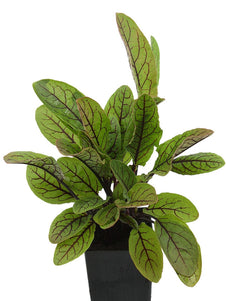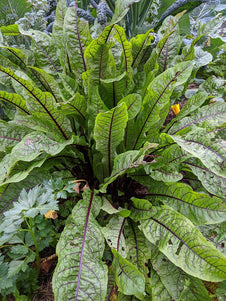



Sorrel - Red Sorrel
Sorrel - Red Sorrel

- In stock, ready to ship
- Inventory on the way

Usually available: All year
Life cycle: Perennial
Height: 60cm
Position: Sun / part shade
Soil preference: Moist / well drained
This is how we pack and send your Herb Plants to all states except TAS & WA
You will receive
- 1 Red Sorrel Herb Plant in a 50 X 75mm tube - General growing instructions
All of our Herb Plants are grown organically with certified organic potting mixes and fertilizers
Botanical Name: Rumex sanguineus
Red sorrel is an attractive herbaceous perennial and one of about 200 species belonging to the genus Rumex. It has the look of spinach, with the green leaves described as lance shaped, from 5-14 cm long. The characteristic red-purple veins are quite striking and may be more prominent in the summer months. This colouring also gives the red sorrel the names ‘bloody sorrel’, ‘bloody dock’ or ‘red veined dock’.
There are various reports on the height attained by red sorrel, but an average seems to be 60cm by 40cm wide. It may grow higher in good conditions with one meter recorded as maximum height. The plant itself spreads, with a rosette like base creating a clump of leaves above the taproot. The tall spikes of tiny, greenish flowers appear in summer. Small, brown fruits, containing seeds, appear after flowering.
Red sorrel is an attractive plant that does well in borders and adds a striking ornamental feature to any vegetable garden. Sorrels do contain oxalic acid, a poison, which may need consideration where animals are concerned. Intake of oxalic acid can affect the way other chemical are managed in the body. This can result in also mineral deficiency, even though it appears that there are no outward effects.
Growing Conditions
Red sorrel is generally a plant that requires little attention, doing well in warm climates and growing in cooler areas. In the tropical areas, it can be grown as a cool season annual. It prefers full sun, but this may depend upon how hot the garden aspect is. Sorrel can tolerate part shade and some gardeners recommend a sheltered position. Sorrel is considered vulnerable to frost and will need some cover or protection if it is to survive.
The best soil for red sorrel is one that is consistently moist, but well drained. Monitor watering, although sorrel will tolerate some dryness, the plants may wilt. The quality of the soil does not have to be rich, but the addition of animal manure will help improve lighter soils.
Sorrel is propagated by seed sown directly into the garden or by wind pollinated, self-sowing seed in later years. Seedlings should be thinned to approximately 30 cm apart. Mature plants can be divided and transplanted once the leaves and stems have been trimmed. The plants benefit form pruning after flowering to encourage new growth. If you do not wish sorrel to self-seed, remove the seed heads before the wind dispersal begins.
Culinary Uses
Red sorrel is considered to be an ornamental vegetable, rather than a culinary herb. In the past sorrel was a culinary herb, but it is known to contain oxalic acid, which gives the herb its lemony taste. The young leaves of sorrel can still be used sparingly in salads, but other varieties of sorrel may be more useful for most other culinary purposes. In general, sorrel may be used for sauces and soups, salads and omelettes. Some sources note that mild stomach ache may occur if sorrel is consumed.
Other Uses
Red sorrel is recommended as a semi-water plant, placed at the edge of a pond for added colour. It can take part shade so this is often helpful with pond plants.
All information provided on this website is for informational purposes only. Please seek professional advice before commencing any treatment.





